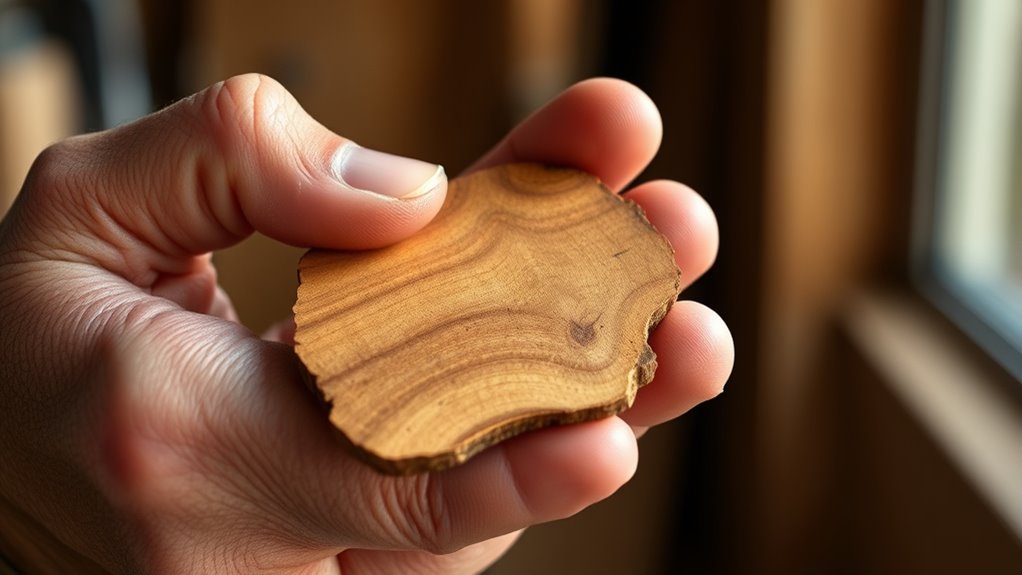To identify wood by smell, familiarize yourself with 12 key aromas that reveal a lot about different species. Recognize scents like the sweet aroma of oak, the fruity hint in cherry, or the subtle, clean smell of maple. Your nose can help distinguish woods even when visual cues are tricky. Developing this skill will improve your accuracy and confidence. Keep exploring these aromas, and you’ll discover even more insights into each types’ unique character.
Key Takeaways
- Recognize distinctive scents like cedar’s piney aroma or cherry’s fruity smell to identify wood species accurately.
- Practice smelling different woods regularly to develop an intuitive sense of their characteristic aromas.
- Use aroma cues alongside grain patterns to improve identification, especially with similar-looking species.
- Understand that certain scents indicate natural oils or resins affecting finishing choices and durability.
- Familiarize yourself with the 12 key aromas to quickly assess and select suitable woods for projects.

Have you ever wondered if you can identify different types of wood just by their smell? It might sound unusual at first, but many experienced woodworkers rely on their sense of smell to distinguish between woods, especially when visual cues aren’t enough. The aroma of wood is influenced by its unique chemical compounds, which also affect the grain patterns and how the wood responds to finishing techniques. Recognizing these scents can help you select the right timber for your project, ensuring quality and consistency from start to finish.
Identifying wood by smell helps ensure quality and guides finishing choices.
When you smell a piece of wood, you’re picking up on more than just its scent; you’re also sensing its grain patterns. Different species have characteristic smells that can hint at their grain structure. For example, oak often has a strong, slightly sweet aroma with pronounced grain patterns that can be easily seen and felt. Cherry, on the other hand, tends to emit a mild, fruity scent and features tight, fine grain patterns that give it a smooth appearance. Maple has a subtle, clean smell, often accompanied by a consistent, uniform grain pattern. By paying attention to these aromas, you can match the scent to the visual cues, making identification more accurate.
Your nose can also guide you in choosing appropriate finishing techniques. Some woods, like cedar, have natural oils that give off a distinctive smell and require specific finishing procedures to enhance their natural beauty while preventing issues like blotching or uneven absorption. Others, like mahogany, have a mellow aroma that pairs well with certain stains and sealants, helping you achieve a rich, even finish. The scent can indicate the presence of oils, resins, or tannins, which influence how the wood absorbs stains and reacts to finishing products. Knowing this allows you to tailor your approach, ensuring your final piece looks professional and lasts. Additionally, understanding the aromatic profile of different woods can help prevent misidentification and improve your selection process.
Mastering the art of identifying wood by smell takes practice, but it’s a skill that can save you time and improve your craftsmanship. As you work with different species, take note of their scents and how they complement their grain patterns and finishing characteristics. Over time, you’ll develop an intuitive sense for matching aroma with visual and tactile clues, making you a more confident and knowledgeable woodworker. Remember, your nose is a valuable tool—use it to enhance your understanding of wood, and you’ll create better projects with less guesswork.
Frequently Asked Questions
Can Artificial Finishes Alter a Wood’s Natural Smell?
Artificial finishes can definitely alter a wood’s natural smell. Finishing odors from products like varnishes and sealants can mask or change the wood’s original scent. This scent masking occurs because these finishes emit strong fumes that overpower the wood’s aroma. As a result, you might not notice the natural smell anymore, making it harder to identify the wood by scent after applying artificial finishes.
How Does Wood Age Affect Its Aroma?
Imagine opening a weathered wooden chest and inhaling its deep, warm scent—this is how wood aging influences aroma changes. As wood ages, its aroma evolves, becoming richer and more complex, much like a fine wine. Over time, natural oils and resins develop, enhancing its scent. You’ll notice fresher smells fade, replaced by subtle, earthy notes that tell the story of its history and maturation.
Are There Safety Concerns When Smelling Certain Woods?
When smelling certain woods, you should be aware of dust hazards and allergic reactions. Some woods release dust or volatile compounds that can irritate your respiratory system or cause skin reactions. It’s best to wear a mask and work in a well-ventilated area to reduce these risks. Always identify the wood’s aroma beforehand, and if you notice any discomfort, stop smelling it immediately and seek medical advice if needed.
Can Synthetic Woods Mimic Natural Wood Scents Accurately?
Imagine inhaling a fresh, earthy aroma that instantly transports you to a cozy workshop. Synthetic scent can sometimes mimic natural wood’s aroma replication, but it often falls short of capturing the nuanced, warm essence. While some synthetic woods offer convincing aroma replication, they rarely evoke the full depth and character of genuine wood scents. You might notice a faint artificial note, reminding you that it’s a crafted imitation, not nature’s true aroma.
Is Smell a Reliable Method for Identifying Exotic Woods?
You might wonder if olfactory identification is reliable for exotic woods, but scent variability can make it tricky. Relying solely on smell isn’t foolproof because different batches, age, and environmental factors alter the aroma. While experienced woodworkers can often recognize certain woods by scent, it’s best to use smell as a supplementary tool alongside visual and tactile cues for accurate identification.
Conclusion
By learning to identify wood by smell, you unseal a secret language that whispers beneath your fingertips. With each aroma, you gain a new tool, turning your workshop into a symphony of scents that guides your craftsmanship. Trust your nose—it’s like a compass pointing you toward the perfect piece. Embrace these scents, and watch your woodworking skills blossom as naturally as a tree reaching for the sun.









